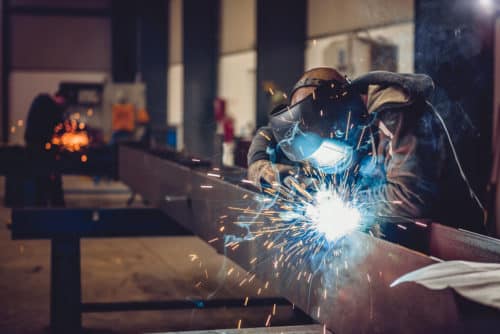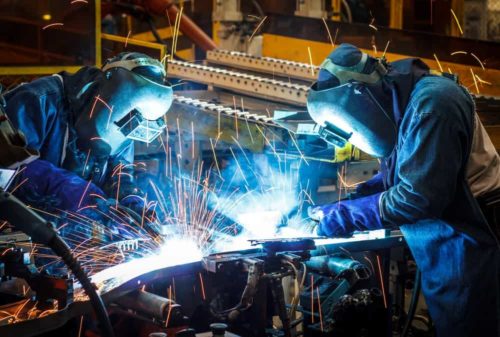
For more than a century, G.E. Mathis Company has been a reputable name in the metalworking industry. Our extensive selection of metal fabrication services includes specialized stainless steel welding for industries ranging from chemical manufacturing and food service to construction and defense.
Welding Process Overview
Stainless steel welding operates under the same basic welding principles as all metals. Just like other welding techniques, heat and sometimes pressure are applied to the base material at the point where you are joining two or more pieces of metal. Depending on the specific project and process, filler material may be melted along the joint and then allowed to cool.
The resultant material is a hard metal bonded to the surface material of each piece that holds them together in a solid joint. In order to prevent weak joints, the filler material must have a level of strength and hardness equal to the component pieces. The strength provided by the joining material is what ultimately provides a stronger bond when compared to other techniques, such as soldering or brazing.
Stainless Steel Welding Methods
Stainless steel welding typically involves some form of arc welding combined with specialized work holding solutions known as fixtures. Fixture welding uses a specialized tool to hold the stainless steel pieces in place. This ensures straight, clean welded seams without inconsistencies. To facilitate numerous clamp and brace configurations, a fixture table is constructed with numerous holes and openings.
This allows the welder to weld a wide range of sizes and shapes from numerous angles without worrying about unwanted movement or shifting. Fixture welding is particularly useful for stainless steel, as it allows a high degree of control over the position of the welding equipment and the component parts.
For the actual welding process, arc welding stainless steel offers the highest level of temperature control, which helps to ensure strong and accurate welds. In addition, a variety of filler materials can be used to improve weld strength when combined with the stainless steel material. The two most common arc welding techniques used with stainless steel include tungsten inert gas (TIG) welding and metal inert gas (MIG) welding. Each method uses a different approach to achieve the desired results.
Tungsten Inert Gas Welding
Tungsten inert gas (TIG) welding is a form of arc welding that uses a non-consumable tungsten electrode to create an arc of electrical current. The arc is shielded by an inert gas such as helium or argon and used to heat the filler material to weld multiple pieces together. TIG welding is highly valued for use in stainless steel welding because the level of heat can be easily controlled remotely with a foot pedal or fingertip controls.
Metal Inert Gas Welding
Metal inert gas (MIG) welding uses an electrical current from a consumable or non-consumable electrode. The heat generated by the electrical current is used to melt filler materials to join two or more metal pieces together. This form of arc welding can be automated or performed manually, and the filler material can double as the electrode.
G.E. Mathis Company Welding Solutions

In addition to being an ISO 9001:2015-certified manufacturer, G.E. Mathis Company can provide the following services:
- PPAP (Production Part Approval Process) – All Levels
- FAIR (First Article Inspection Report)
- Capability Studies (Statistical Process Control)
- CMRT (Conflict Minerals Reporting Template)
G.E. Mathis Company is dedicated to providing the highest levels of quality, integrity, and craftsmanship in the industry. We help our customers reach their goals by providing a combination of expertise, rigorous quality assurance, and personalized service. To learn more about G.E. Mathis Company’s stainless steel welding and other metalworking capabilities, contact us or request a quote today.













